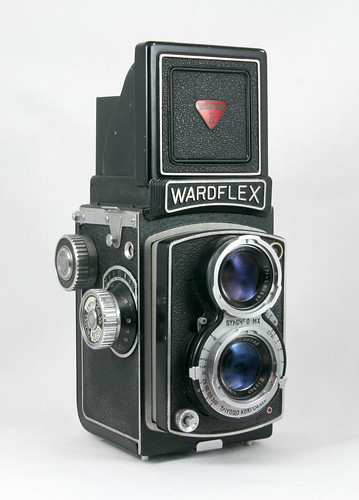Difference between revisions of "Wardflex (metal)"
m (Commented-out misleading statement about filter bayonets. Changed Butkus link - no manual for the Wardflex.) |
(→Links) |
||
| Line 15: | Line 15: | ||
==Links== | ==Links== | ||
| − | *[http://www.butkus.org/chinon/wardflex/wardflex_ii/wardflex_ii.htm Wardflex II | + | *[http://www.butkus.org/chinon/wardflex/wardflex_ii/wardflex_ii.htm Wardflex and Wardflex II PDF manuals] at Michael Butkus Jr.'s [http://www.butkus.org/chinon/index.html Camera Manual Library] |
*[http://www.tlr-cameras.com/Japanese/Taiyodo.html Study on Taiyodo Koki TLR's including the Wardflex] on [http://www.tlr-cameras.com/index.htm Barry Toogoods TLR Cameras Website] | *[http://www.tlr-cameras.com/Japanese/Taiyodo.html Study on Taiyodo Koki TLR's including the Wardflex] on [http://www.tlr-cameras.com/index.htm Barry Toogoods TLR Cameras Website] | ||
Revision as of 15:19, 14 May 2023

|
| Wardflex II image by KKinOK (Image rights) |
The 1955-type Wardflex was built in Japan by Taiyōdō Koki (TKK), and is a rebranding of a Beautyflex T model. This model has a TKK shutter and Telmer 80mm f/3.5 lenses.
In 1957, Wards offered a higher-spec Wardflex II, which is a rebranding of the Beautyflex D. The viewing lens is a Tri-Lausar and the taking lens is a Biokor f/3.5. The five bladed Syncro MX shutter has speeds of 1-1/300 of a second with bulb mode and eight stops at 1, 1/2, 1/5, 1/10, 1/25, 1/50, 1/100 and 1/300 of a second. This can be adjusted on the right hand side of the taking lens. The left hand side of the taking lens has the aperture adjustments. While the bottom has a self timer with a 10 sec delay.
Links
- Wardflex and Wardflex II PDF manuals at Michael Butkus Jr.'s Camera Manual Library
- Study on Taiyodo Koki TLR's including the Wardflex on Barry Toogoods TLR Cameras Website

|
| Mid-50s Wardflex with TKK shutter image by Shutter Tripper (Image rights) |